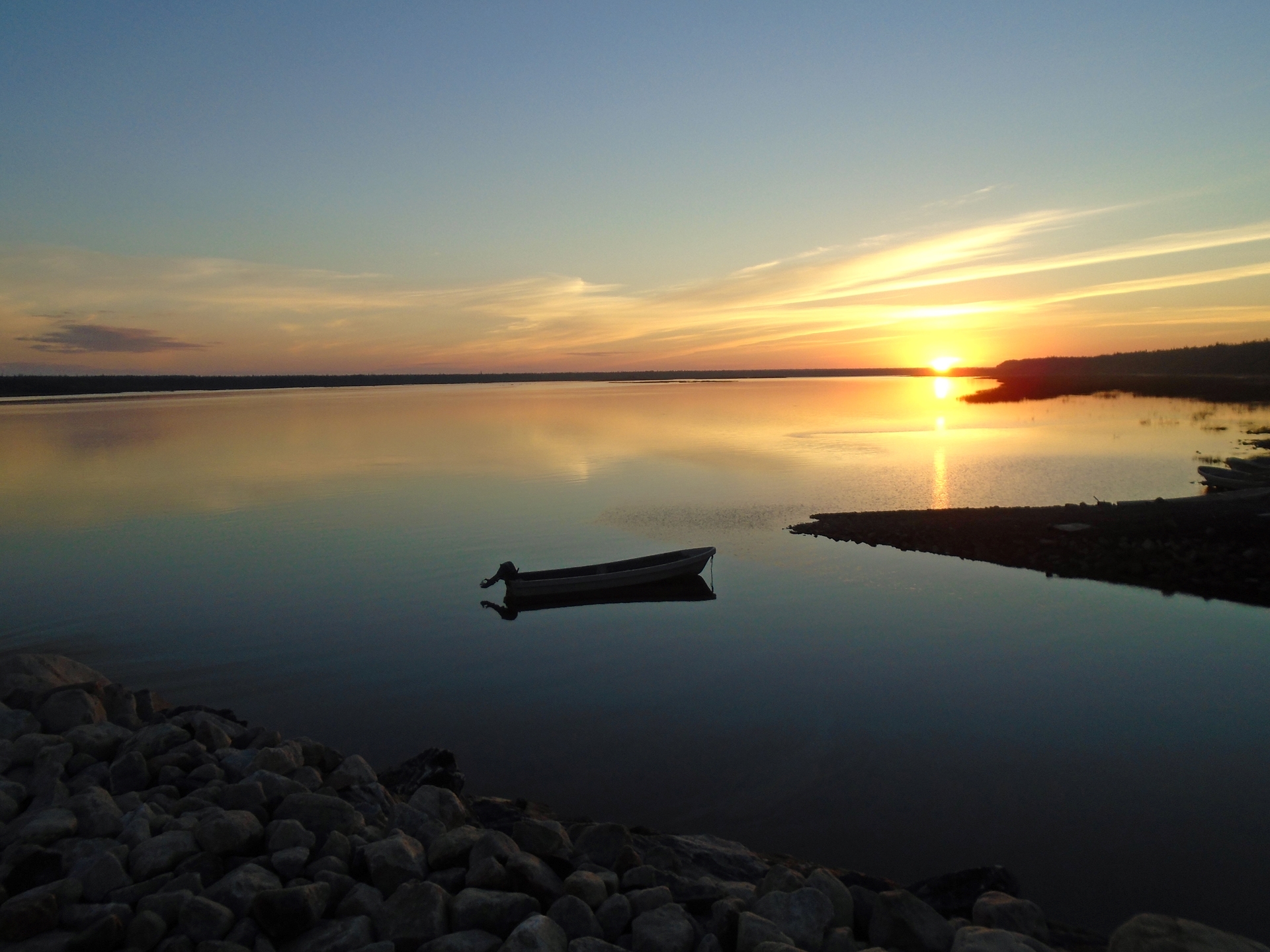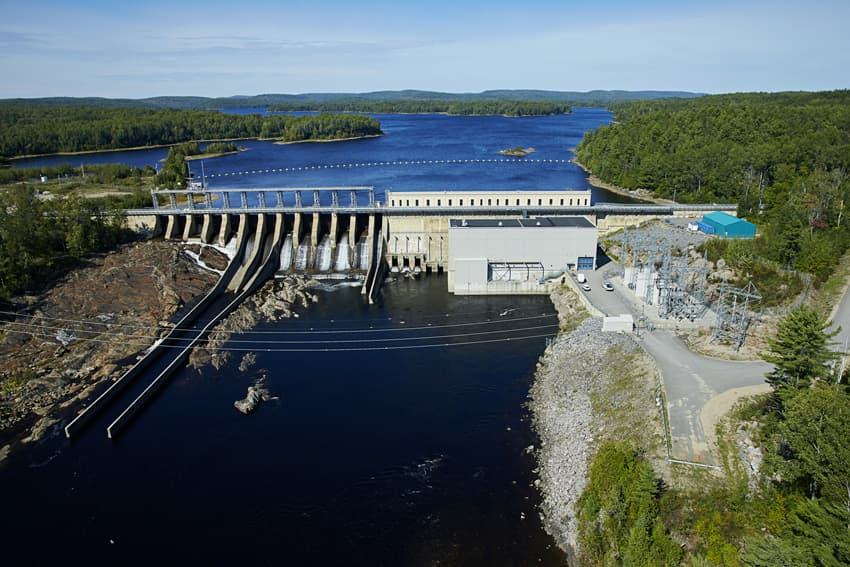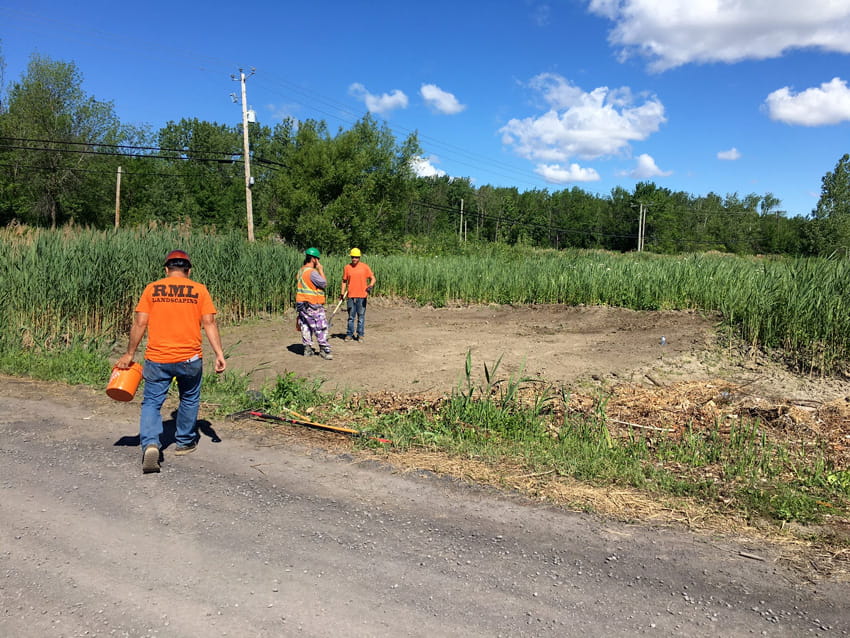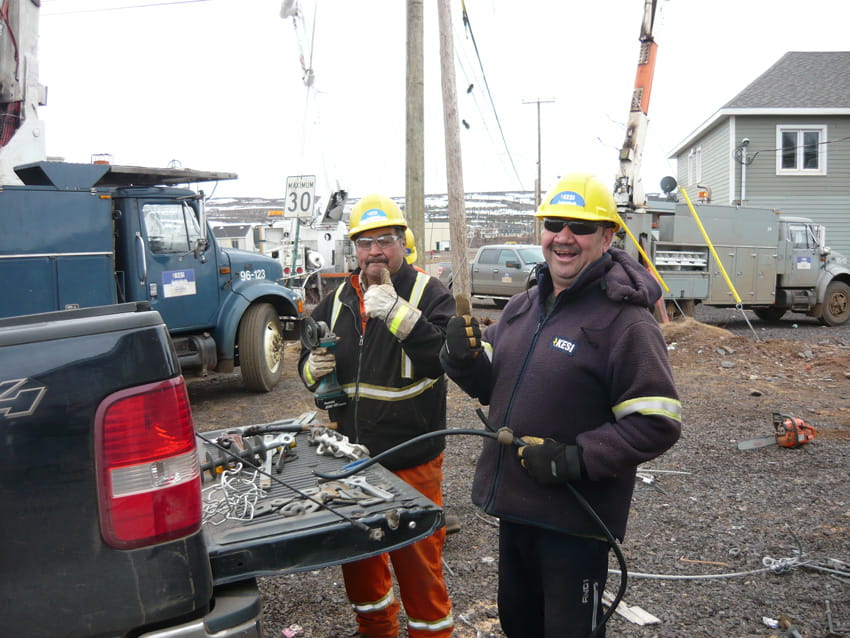Portrait of Indigenous nations

Québec is home to 11 Indigenous nations that account for about 1% of the province’s population. More than half of Indigenous people live in 55 communities.
Each nation has it own culture, language and social organization. The level of social and economic development varies widely not only from one nation to the next, but also from one community to the next within the same nation. Geographic location also plays a crucial role in daily life in Indigenous communities.
English is the language of communication with Hydro-Québec for about two-thirds of these communities, the other one-third communicating in French. Numerous place names testify to the presence of Indigenous peoples on the land. These names are how the land tells its story and are of great historic and place memory value.
Discover the nations

Legend
-
Abenakis or Waban Aki
-
Algonquins or Anishnabe
-
Atikamekws or Nehirowisiwok
-
Cris or Eeyou
-
 Hurons-Wendats
Hurons-Wendats -
 Innus
Innus -
 Inuits
Inuits -
 Maliseets or Wolastoquyik
Maliseets or Wolastoquyik -
 Mi’kmaq or Mi’gmaq
Mi’kmaq or Mi’gmaq -
 Mohawks or Kanienkehaka
Mohawks or Kanienkehaka -
 Naskapis
Naskapis
Legend
Legend
-
Abenakis or Waban Aki
-
Algonquins or Anishnabe
-
Atikamekws or Nehirowisiwok
-
Cris or Eeyou
-
 Hurons-Wendats
Hurons-Wendats -
 Innus
Innus -
 Inuits
Inuits -
 Maliseets or Wolastoquyik
Maliseets or Wolastoquyik -
 Mi’kmaq or Mi’gmaq
Mi’kmaq or Mi’gmaq -
 Mohawks or Kanienkehaka
Mohawks or Kanienkehaka -
 Naskapis
Naskapis
 The Abenaki or Waban Aki Nation
The Abenaki or Waban Aki Nation
The word Abenaki comes from the words Waban (dawn) and Aki (land) and it means “People of the Rising Sun” or “People of the East.” We owe the place names Memphrémagog and Coaticook, which mean “vast expanse of water” and “river of the pines,” to the Abenaki language.
Conflicts with British colonists in the second half of the 17th century led Abenaki groups living in New England to move to New France. They settled in Odanak, near Pierreville, and in Wôlinak, along the shores of the Rivière Bécancour.
The main economic activities of these communities in the 19th century were handicrafts, agriculture, hunting and fishing. Members of the Abenaki Nation also worked as guides in the hunting and fishing clubs of the Mauricie until the mid 20th century.
Today, the band councils are the main employers. A number of companies were also formed in recent decades in the communities of Odanak and Wôlinak, where about 400 of Québec’s 2,700 Abenaki reside.
French is the main language spoken by the members of this nation.
Examples of collaboration
- 2019‑2021: The Abenaki participate in a land use study and in the archaeological component of the environmental impact study for the Appalaches–Maine interconnection line project.
- 2017: Hydro-Québec supports a school project at the Musée des Abénakis in Odanak.
- 2009: The Fondation Hydro-Québec pour l’environnement funds a project for protection and enhancement of ecologically sensitive environments in Odanak.

 The Algonquin or Anishnabe Nation
The Algonquin or Anishnabe Nation
The word Anishnabe means “human being.” This nation has about 6,000 members who live in nine communities in Abitibi-Témiscamingue and Outaouais. Some of these communities, such as Kitigan Zibi and Pikogan, are quite close to non-Indigenous communities (Maniwaki and Amos), while others are more isolated.
Six of the nine Algonquin communities communicate in English with Hydro-Québec. Preservation of the Anishnabe language is a major challenge for many of these communities.
The hydroelectric potential of the watershed of the Rivière des Outaouais was developed mainly between 1900 and 1950, that is, before full nationalization of electricity in Québec. The Baskatong, Dozois and Cabonga reservoirs were impounded during this period. The name Cabonga derives from the Algonquin word Kakibonga, which means “entirely blocked by sand.” This place name was used before the reservoir was created.

The Algonquin communities of Kitcisakik and Lac-Rapide are located along the shores of the Dozois and Cabonga reservoirs.
Examples of collaboration
- 2018‑2021: The Algonquin communities of Lac-Simon and Pikogan are involved in the land use study for a transmission line project in Abitibi.
- 2015: Hydro-Québec dismantles the decommissioned Corbeau generating station near the community of Kitigan Zibi. The work is entrusted to an Algonquin firm and the land on which the old generating station was located (4.8 hectares) is transferred to the community.
 The Atikamekw or Nehirowisiwok Nation
The Atikamekw or Nehirowisiwok Nation
Tapiskwan Sipi, ... that’s what the Atikamekw Nehirowisiwok call the Rivière SaintMaurice, its 400 kilometres (from Gouin reservoir to Trois-Rivières) studded with dams and generating stations. Sipi means river and tapiskwan suggests a thread running through a needle, an expression that evokes the many rivers intersecting and emptying into the Rivière Saint-Maurice.
Most of the hydroelectric structures in the Rivière Saint-Maurice basin were built before Hydro-Québec was created. They initially served to regulate the flow in the Rivière Saint-Maurice and supply private facilities connected to the forestry industry.
Atikamekw is one of the best-preserved Indigenous languages in Canada, and French is the second language of Québec’s approximately 8,000 Atikamekw.
Hunters of the boreal forest, the Atikamekw live in three communities (Manawan, Opitciwan and Wemotaci) that are accessible only by forestry roads. This geographic setting fostered the involvement of these communities in the forestry industry. Atikamekw firms regularly perform vegetation control work under Hydro-Québec’s transmission lines.
Examples of collaboration
- 2019: Hydro-Québec signs an agreement with Manouance Sipi (limited partnership) for purchase of electricity over a period of 20 years. This company will build and operate a hydroelectric generating station on the Rivière Manouane, a tributary of the Rivière SaintMaurice. Manouance Sipi is a joint venture of the Atikamekw Council of Wemotaci and the City of La Tuque.
- 2015: Hydro-Québec signs an agreement with the Atikamekw Nation in connection with the Chamouchouane–Bout-de-l’Île line project. This agreement provides for acquisition of fibre optics of Hydro-Québec facilities by the community of Wemotaci to improve their telecommunications service.
- 2005‑2009: Atikamekw firms and workers from Wemotaci participate in the construction of the new Chute-Allard and Rapides-des-Cœurs generating stations located not far from their community.

 The Cree or Eeyou Nation
The Cree or Eeyou Nation
Eeyou means human. There are nine Eeyou Nation communities in Québec. Though all of them are located in remote regions, only one cannot be reached by road. Most members of the Cree Nation, population approximately 20,000, speak the Cree language, Iiyiyuu Ayimuun. The Cree alphabet, which is syllabic, has 52 symbols.
The Grand Council of the Crees collaborated with other Indigenous peoples and nations on the work that led to the United Nations Declaration on the Rights of Indigenous Peoples.
Some twenty agreements govern relations between the Crees and Hydro-Québec. These agreements regulated the construction of the La Grande complex and the Eastmain-Sarcelle-Rupert complex, which together include about a dozen hydroelectric generating stations and multiple dikes and dams as well as transmission lines and substations on the territory of Eeyou Istchee. About half the electricity Hydro-Québec produces comes from Eeyou Istchee.
Diaporama
Le contenu qui suit est un diaporama d’images sur: Les normes
-

Wetland creation – Disposal site for excavated materials from the Rupert diversion, which was redeveloped to create wetlands to facilitate waterfowl hunting for Cree users. -

Caniapiscau reservoir is located along La Grande Rivière, called the Chisasibi by the Eeyou, which means “great river.” Caniapiscau is our largest reservoirs.
Examples of collaboration
-
2021: The Cree Nation Government and Hydro-Québec have been collaborating since 2016 with Niskamoon Corporation on an integrated research program to learn about the ecology of the coastal region of Eeyou Istchee (Baie-James), particularly eelgrass, a marine plant, and its relationship with the geese on which the Crees depend.
For more information about this research project: https://www.eeyoucoastalhabitat.ca/ .
.
-
2016: Read the joint article published on the journal Éthique Publique website: Rebuilding Relations: Hydro-Québec and the Cree Nation (1994-2015) [PDF 686 kB].
This article was translated by Hydro-Québec. The original article was published in French on the journal's Website .
.
-
2007: A joint monitoring committee is created to ensure Cree involvement in the environmental follow up of the Eastmain-Sarcelle-Rupert project.
Video: Eastmain–Sarcelle–Rupert project Monitoring Committee
Duration: 7 minutes 54 secondes
 The Huron-Wendat Nation
The Huron-Wendat Nation
Wendake, located on the outskirts of the city of Québec, is the only Huron-Wendat community in Québec. Over the last two decades, the Huron-Wendat have made huge efforts to revitalize their ancestral language, Wendat. Tourilli, or Atourilli, is one Huron place name. It means “turbulent water.”
A nation of farmers and traders, the Huron-Wendat originally lived along the shores of Lake Huron’s Georgian Bay, in Ontario. Decimated by war and epidemics, Huron families left Georgian Bay in the 1650s and moved to the city of Québec area, finally settling for good in 1697 where the town of Wendake is located today. The proximity to the city of Québec City fostered the emergence of numerous private firms in Wendake, making this Indigenous community one of the province’s most economically dynamic.
Examples of collaboration
- 2021: The Huron-Wendat take part in the archaeological component of the environmental impact study for the Appalaches–Maine interconnection line project.
- 2021: The Huron-Wendat are key participants in the project to dismantle Saint-Narcisse generating station, decommissioned in 2018
Diaporama
Le contenu qui suit est un diaporama d’images sur: Les normes
-

Archaeological dig for the Appalaches–Maine interconnection line project impact study -

Archaeological dig for the Appalaches–Maine interconnection line project impact study
 The Innu Nation
The Innu Nation
The Innu Nation has about 16,000 members who live in nine different communities.
Innu-aimun is the mother tongue of most of this population and the bearer of Innu culture in all its uniqueness, providing not only the vocabulary of day-to-day life but also a world view. Translating from English to Innu-aimun can be quite the challenge. For example, during the draft-design study for the Romaine project, it was discovered that there was no expression in Innu that could render the notion of a mitigation measure. The idea that one might voluntarily modify an environment and then “repair” it was absent from Innu culture. Specialists in the language literally created a new expression, tan tshe tutakanit tshetshi eka shuk mishta-katshitaikanit, which means “what will be done so that we are not too much affected.”
The Innu call the Rivière Romaine Unamen-Shipu, that is, the “ochre river.”
Examples of collaboration
As circumstances require, Hydro‑Québec issues information documents in both French and Innu-aimun.
- 2021: Hydro‑Québec signs a contract to purchase energy produced by the Apuiat project. Initiated by the Innu Nation in partnership with Boralex, this project involves building a wind farm with about 50 wind turbines and a total installed capacity of 200 MW in Port-Cartier in Côte-Nord. Work on the wind farm is to begin in the summer of 2022, with commissioning scheduled for December 2024.
- 2019: A poster on the importance of healthy eating and the presence or absence of mercury in certain animal species is developed in cooperation with the Ekuanitshit community’s health center.
- 2009 to the present: Hydro‑Québec offers contracts to the Société des entreprises innues d’Ekuanisthit for construction of the Romaine complex.
- 1999 to 2017 : As part of the construction of the Romaine complex, Hydro‑Québec and the Innu Nation carried out archaeological research to preserve the archaeological heritage of the Romaine watershed. The wealth of data collected has enriched the ancestral knowledge, writings and memories of the Innu and Eurocanadians who inhabited this region, either simultaneously or at different times. A website dedicated to the archaeology of the Romaine complex [in French only] presents the discoveries.
Diaporama
Le contenu qui suit est un diaporama d’images sur: the importance of healthy eating, in French and in Innu-aimun.
-

Poster on the importance of healthy eating, in French. -

Poster on the importance of healthy eating, in Innu-aimun.
 The Inuit Nation
The Inuit Nation
In Québec, the Inuit live in 14 communities, all of them north of the 55th parallel in Nunavik—“Our Land.” Inuktitut is the mother tongue of the vast majority of Inuit, and English is their second language. Inuktitut can be written in the Latin alphabet or syllabics. Words in the Inuit language are rich in meaning. Inukjuak, the name of one Inuit village, means “big man” or “giant.”
The Inuit communities cannot be reached via the province’s road network, nor are they connected to Hydro-Québec’s main power grid. Instead, they get their electricity from stand-alone off-grid systems powered by thermal power plants running on fossil fuels.
Examples of collaboration
- 2021: Construction begins on the Innavik project. This project to build a run-of-river generating station is an initiative of the Inuit community of Inukjuak and will not only create local jobs during the project construction and operation phases but also help diversify the economy.
- 2019: A first Advisor – Indigenous Relations of Inuit origin takes up office in Kuujjuaq to ensure effective communication with all stakeholders throughout the region.
- 1991: Air Inuit (owned by Makivik Corporation) is launched. This carrier transports Hydro-Québec employees to facilities and jobsites in remote locations in the Baie-James territory and Côte-Nord.
- 1986: Operators and line crews of the Nunavik off-grid systems have been mainly Inuit since 1986.
Video: Our Inuit Employees
 The Maliseet or Wolastoquyik Nation
The Maliseet or Wolastoquyik Nation
The homeland of the Maliseets is the watershed of the St. John River, which extends across the borders of New Brunswick and Québec. This region used to be called Wolastoq, which means “beautiful river” in Maliseet.
In Québec, the Maliseet frequented what is now the Bas-Saint-Laurent region, where the Rivière Mitis is located.

In the late 19th and early 20th centuries, tourism and work in the forestry industry were the main sources of income for the Maliseets of Québec.
Today there are two Maliseet reserves in Québec, the Cacouna and the Whitworth. Both these reserves are small, resulting in the dispersal of members of this nation off reserve.
Examples of collaboration
- 2021: The Maliseets participate in a Hydro-Québec project to modify the management of Lac Mitis water levels. They are asked to take part in land surveys and in discussions on study specifications and results.
- 2021: At the request of the Maliseet Nation, Hydro-Québec connects the Whitworth reserve (till then uninhabited) to its grid to allow development of commercial infrastructure.
 The Mi’kmaq or Mi’gmaq Nation
The Mi’kmaq or Mi’gmaq Nation
The place name Gaspé comes from the Mi’kmaw word Gespeg, which means “end of the Earth.” The Mi’kmaq traditionally harvested the fruits of the sea. Their offshore fishery dates back centuries, as illustrated by the ancient canoes designed for paddling through ocean waters.
Before the arrival of the Europeans, the Mi’kmaq occupied a territory that today covers Nova Scotia, New Brunswick, Prince Edward Island and part of Gaspésie.
During the 1800s, Mi’kmaw families gradually settled in Listuguj and Gesgapegiag, in the Baie des Chaleurs, as well as in Gaspé. At the turn of the 20th century, the Mi’kmaq of Québec lived primarily from hunting, fishing and a little farming. Some had seasonal jobs as guides and worked in winter in the logging camps. The sale of baskets and other craft products also provided some income.
Today, about 7,000 Mi’kmaq live in Québec and they mainly speak English. These communities are working to revitalize their language, but it is a real challenge because only a few speakers are left.
Examples of collaboration
- 2014: Hydro-Québec signs a contract with the Mi’kmaw Nation of Québec to purchase wind energy. Commissioned in 2016, the 150-MW Mesgi’g Ugju’s’n wind farm will generate revenues for the Mi’kmaq communities over a period of 20 years.
Diaporama
Le contenu qui suit est un diaporama d’images sur: Mesgi’g Ugju’s’n wind farm
-

Mesgi’g Ugju’s’n wind farm -

Mesgi’g Ugju’s’n wind farm
 The Mohawk or Kanienkehaka Nation
The Mohawk or Kanienkehaka Nation
Québec’s three Mohawk communities are located close to urban areas, near Montréal. Some 16,000 Mohawks live in Québec. Proud of their cultural heritage, they still identify as the Kanien'kehá:ka, the “people of the flint.” Kanien'kéha, the Mohawk language, is spoken by about 2,300 people in Québec and Ontario.
A trail still used today running along the Sault-au-Récollet cemetery between Boulevard Henri-Bourassa and Avenue Camille-Paquet in Montréal is called Tetewaianón:ni Iakoiánaka’weh, or “messenger’s trail” in the Mohawk language, referencing a land route between Ville-Marie and Fort-Lorette used to avoid a difficult-to-navigate stretch of the Saint-Laurent and Rivière des Prairies.
The Mohawks have forged a reputation as highly skilled and fearless high steel workers since the 19th century.
Examples of collaboration
- 2021: Hydro-Québec signs an agreement in principle with Kahnawà:ke, opening the way for an unprecedented partnership allowing the community to become part owner of the Hertel–New York transmission line to be built to export electricity to the United States. Under this agreement, the community will also play an active role in certain draft design studies, including the archaeological study.
-
2020: Kahnawà:ke firms take part in the dismantling of two transmission lines that run through the community and perform restoration work.

Travailleurs mohawks de l’entreprise RML (Rice Mohawk Landscaping) procédant au réaménagement de l’emprise dans le cadre du projet de démantèlement de ligne à Kahnawà:ke - 1991: Hydro-Québec creates the position of Coordinator – Amerindian Relations to facilitate discussions with the Mohawk communities of Akwesasne and Kahnawà:ke. Today, we have two Mohawk employees in Kahnawà:ke dedicated to customer service. The company also has service contracts with the band councils, which hire Indigenous liaison officers to handle customer services.
 The Naskapi Nation
The Naskapi Nation
The Naskapi Nation has some 1,300 members, about 900 living in the community of Kawawachikamach, near Schefferville. Most speak the Naskapi language, or Lyuw iyimuun, with English as a second language. The Naskapi language can be written in syllabics or the Latin alphabet. The Naskapi call themselves the Lyuch, which means “people.” Culturally, the Naskapi are closely related to the Innu. As with the Innu, the caribou is central to Naskapi culture and is probably the most important animal for the people of this nation, providing food, clothing, shelter and tools.
Kawawachikamach is an isolated community unconnected to the provincial road network. It can only be reached by plane or train. It is not far from the Innu community of Matimekush-Lac John.
A semi-nomadic people, the Naskapi settled in 1956 near the new mining town of Schefferville, where they could find employment. During this period, the Iron Ore Company of Canada operated an iron deposit in the area. In 1982, despite the closing of the mine, the Naskapi and the Innu remained near Schefferville. It was only in 1984, after the Northeastern Québec Agreement was signed, that the Naskapi built their own village, Kawawachikamach, 10 km from Schefferville.
Examples of collaboration
- 2019: The Naskapi Nation, the Innu Nation, Hydro-Québec and the Government of Québec sign the Specific Agreement to Preserve the Cambrian Lake / Nachicapau Lake / Fort Mackenzie (Waskaikinis) Area. This 20-year agreement stipulates temporary measures to protect areas with significant natural resource exploitation potential.
- 2007: Kawawachikamach is supplied with electricity by Hydro-Québec under an agreement with Kawawachikamach Energy Services Inc. (KESI). This firm is responsible for the distribution system as well as for meter reading in the Schefferville area.
Diaporama
Le contenu qui suit est un diaporama d’images sur: Employees of the Naskapi firm Kawawachikamach Energy Services Inc.
-

Employees of the Naskapi firm Kawawachikamach Energy Services Inc. (KESI). -

Employees of the Naskapi firm Kawawachikamach Energy Services Inc. (KESI).